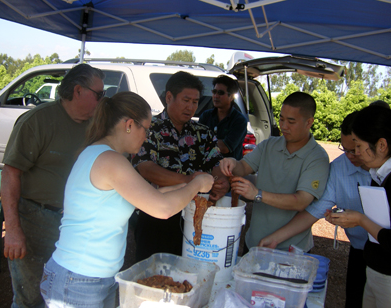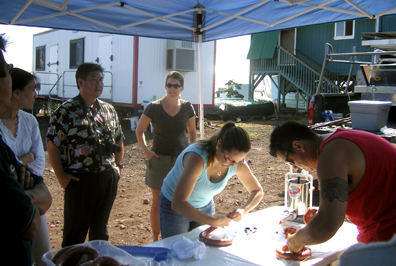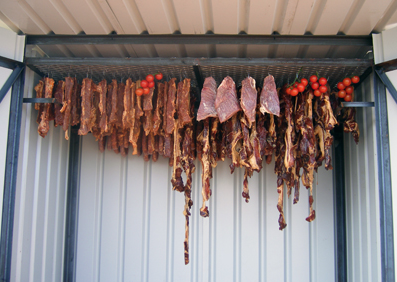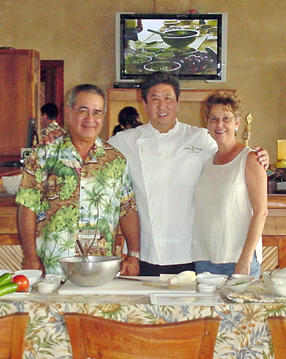Richard Ha writes:

Chef Alan Wong is featured in this week’s MidWeek magazine. Jo McGarry, the Honolulu Star-Bulletin’s Restaurant Specialist, writes about Chef Alan’s commitment to island-fresh products grown by local farmers. I’m in the picture with Chef Alan.
In the article, she mentions his bringing some of the staff from his Hawai’i restaurants to visit Hamakua Springs. Let me tell you about that visit, and about them cooking for us.

First, it’s pretty amazing how Alan Wong treats his farmers. When our farm personnel visit his restaurants, they are treated like royalty. To Chef Alan, the farmers are the celebrities. He keeps telling us that he cannot make products better; that he is limited by what he has to work with. Although we don’t know if we believe that, it’s starting to sink in. Knowing this, we try to do the best we can.
Once Kimo and Tracy went to the Pineapple Room, unannounced. Restaurant Manager Barbara Stange recognized them and notified her staff that the people from Hamakua Springs Country Farms were in the house.
Kimo and Tracy both said they had never experienced anything like it: It seemed like they were assigned extra wait staff. They were brought extra dishes to sample. People were saying, “Try this, it’s made with cocktail tomatoes.” And, “Here’s another dish.” I’m sure Chef Alan does this for all his farmers. But it makes us want to take special care of all the products we supply him.
A few months back he brought some of the staff from his Hawai’i restaurants to visit the Big Island farmers on the Hamakua coast. He said it helps the staff describe his creations when they know the farmer who grow the product.
When he visited us, we showed him several things we were testing. A few months before, Chef Alan had expressed interest in creating a dessert with a specialty melon cut in half and served with a scoop of ice cream.
 So we have been testing melons. That picture is of Chef Alan checking the melon for aroma. He gave his approval, and so we are now proceeding on to production. The next step is to get the melons to his restaurants and to make sure everything is right. After that we will bring it to the supermarkets. But first things first. We need to prove that we can deliver sweet melons each time, all the time.
So we have been testing melons. That picture is of Chef Alan checking the melon for aroma. He gave his approval, and so we are now proceeding on to production. The next step is to get the melons to his restaurants and to make sure everything is right. After that we will bring it to the supermarkets. But first things first. We need to prove that we can deliver sweet melons each time, all the time.
We took everyone on a tour of our farm, where I explained our sustainable farming philosophy and how it drives our decision-making. They saw how we use high-tech monitoring of environmental conditions inside of a low-energy-consuming growing house.
We run the irrigation controllers with a few D batteries. We don’t use electricity at the tomato houses and all our water is free. We leave the tomatoes on the plants to ripen naturally for as long as we can. We continuously monitor sugar content of the tomatoes so we are sure they are sweet. I demonstrated how we take leaf samples, which we send to a lab to assess the plant’s nutritional status. Then we make up a custom fertilizer that helps to give it a rich and sweet flavor.
We are mindful of the effect our farming might have on the environment, so we are careful not to over-fertilize. Our tomato houses are surrounded by strips of vegetation that help prevent any excess fertilizer from reaching any streams.
Chef Alan gave us pointers about what he looks for in the various crops we grow, and we showed him how to drive a bulldozer. He and Kimo went in the back and pushed some soil around. Chef Alan got to make a pile and level it off, pack it down and then back blade it for a nice finish. He learned that you steer the bulldozer by locking one brake or the other. In that way you can even spin the machine around in one spot. He had an ear-to-ear grin when he cruised by on his way to park the machine. Now that we know his weakness, we’re going to trade lessons on the backhoe for another cookout.

We put up a tent so we could do this and keep the farm running. Besides the immediate family, our supervisors came. Leslie Lang, our neighbor and future Chief Blogger, was there. Bob and Janice Stanga (of Hamakua Mushrooms) brought their Hamakua mushrooms, Lesley Hill and Mike Crowell (Wailea Agricultural Group) provided heart of palm, Dick and Heather Threlfall (Hawaii Island Goat Dairy) provided goat cheese, we supplied tomatoes and greens, and the chefs brought li hing mui/ume dressing with them, and wine. (We got to keep the extra li hing mui dressing). They also bought loads of stuff from the Hilo Farmers Market.
When they all started into action preparing the dinner, it looked like there were 50 things going on at once. Barbara Stange and Leigh Ito, also of Alan Wong’s staff, were making different kinds of salads that were so nice to look at. The head of the wait staff and Chef Alan’s front-of-the-house personnel were busy doing the finishing touches on dishes never before seen at Hamakua Springs Country Farms.

Then they fired up the grills and started cooking. Grandma Ha was thrilled that Chef Alan was cooking for us. She told him, “Give me the recipe, okay?” Mom can do that–she has seniority. (That’s my mom and Alan Wong on the right.) Chef James of the Hualalai Grille was on one burner, Chef Neil, Chef de cuisine from the Pineapple Room was on another, and Executive Chef Lance was on another.
The food was delicious and we tried everything. They brought beer and wine and there was animated conversation going on all around.
Chef Alan, Dan Nakasone and I have pineapple-picking stories in common. Tracy and a small audience cornered Chef Lance, who was at a burner demonstrating the finer points about preparing risotto. (You have to keep your eye on it.)
Some of the guys were trading pig hunting stories with the Hualalai Grille staff. Why was I surprised that they would know anything about pig hunting, just because they are associated with a restaurant that has won nine ‘Ilima awards and is the quintessential Hawaii Regional Cuisine restaurant?

We realized that they are all normal, everyday people, like you and me. But they are incredibly good at what they do. We like to think that we are kind of like that, too. We all live here in Hawai’i, with all of the local influences. At the end of the evening we were like good old friends. And, can you imagine–we got to give all our people take-home plates of Alan Wong’s creations.
Life on the farm will never be the same.
Now we know what happens to the products we grow and how important it is to provide the best quality possible. We used to be concerned about our products until they left the farm’s loading docks. Now we worry about everything that goes on after they leave our farm and until they reach Chef Alan’s door. And that makes us better farmers.









 “I could tell that she really wanted to get her hands on the lettuces,” he said. “The clincher was when I handed her one. She held it really gently, like it was a baby bird, and I thought to myself, ‘She’s the one.’”
“I could tell that she really wanted to get her hands on the lettuces,” he said. “The clincher was when I handed her one. She held it really gently, like it was a baby bird, and I thought to myself, ‘She’s the one.’”


 So we have been testing melons. That picture is of Chef Alan checking the melon for aroma. He gave his approval, and so we are now proceeding on to production. The next step is to get the melons to his restaurants and to make sure everything is right. After that we will bring it to the supermarkets. But first things first. We need to prove that we can deliver sweet melons each time, all the time.
So we have been testing melons. That picture is of Chef Alan checking the melon for aroma. He gave his approval, and so we are now proceeding on to production. The next step is to get the melons to his restaurants and to make sure everything is right. After that we will bring it to the supermarkets. But first things first. We need to prove that we can deliver sweet melons each time, all the time.

